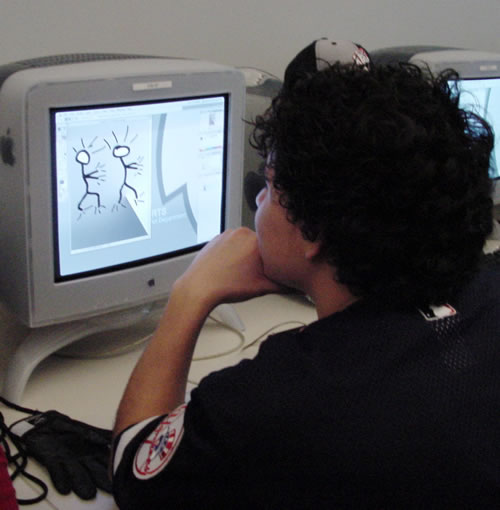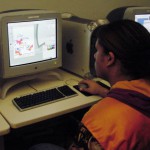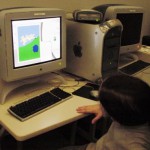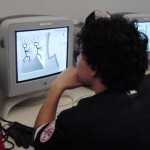
Categories
- Curriculum: Art | Computer | Dance & Music
- Age/Grade: Middle School | Above 14
- Subject: Multi-Media | Drawing
- Materials: Mixed Media
- Institution: School of Visual Arts
- Location: New York, New York
- Duration: 3 - 4 Classes
Description
Integrating art and music, this cohesive lesson seeks to teach students the fundamentals of graphic design by creating their own Haring-inspired CD Covers.
Objective
Learn to combine traditional media with computers to make a mixed media piece of art.
Familiarity with Keith Haring and other modern artists that are inspired by music in making their art.
Vocabulary: Expression, line, repetition, rhythm, improvising, marquee tool, lasso tool, move tool, history brush tool, gradient tool, complementary color, analogous color...
Basic computer skills: scanning a drawing in a computer, saving a file, and printing.
Adobe Photoshop skills: knowledge of the marquee tool, lasso tool, move tool, history brush tool, gradient tool as well as the layer, history and color bar.
Visual literacy skills: ability to observe, describe and interpret works of art.
Ability to capture music, sound, and emotion in an abstract composition using drawing elements.
Ability to express emotion in drawing through various types of line.
Ability to make artistic choices to communicate a specific idea.
Ability to express emotion and mood through colors.
Art does not have to be a literal representation of a person, place, or thing.
Color and abstract shapes can communicate meaning or emotion.
Music and visual art are very similar and can express the emotions moods through different ways.
Resources
Haring web sites
Haring Exhibition catalogs
Materials
Charcoal
8x10 vellum paper
PC or Mac computers
Adobe Photoshop 7.0
Digital projector
Empty CD jewel cases
Procedure
MOTIVATION
Images that relate to music and dance by Keith Haring will be shown on the digital projector. I will bring in the same type of music that Keith listened to that influenced his art. Charcoal drawings will be made that shows how various lines can represent different types of music.
QUESTIONS
1. How do you think the artist felt when he was making this painting?
2. What makes you say that?
3. How do you think color conveys the mood of the piece? Line? Shape? 4. How do artist represent music and mood in painting?
5. What type of music do you think the painting is representing?
6. How do the arrangement of shape, line, and color, create mood?
7. How do you think the painting/sculpture is reflecting the music?
8. What sounds do you hear when looking at the painting?
PROCEDURE
Setting up before class: (10 mins)
1. Turn computers on and check to make sure that Photoshop works and the network connection is running.
2. Check to make sure the scanners and printers are working.
3. Hook up the digital projector to the computer that the demonstration will take place and turn it on.
4. Open Power Point Presentation. Then open the slide show of the images that will be discussed in class.
Class time:
Introduction and discussion: (15 mins.)
1. After students sit down by their computer, start the slide show of the images by Keith Haring.
2. Using open-ended questions, engage the students in a class discussion about the artwork. The objective of the discussion is to show how Keith Haring's artwork was influenced by music and dance.
Drawing Excercise: (15 mins.)
1. Brainstorm different words to describe types of marks and lines that we saw or can think of (smudge, scratch, soft, dark, thick, thin, sloppy, etc.)
2. Students will be asked to experiment with the charcoal to see how many different types of marks they can create.
3. Ask students to create various marks to correspond to emotions (angry, sad, silly, joyous, anxious, etc.)
Drawing while listening to three contrasting types of music.
1. I will play Beethoven symphony No. 9 (10 mins)
-On a large sheet of newsprint paper with charcoal stick, each student will be asked to draw using a series of line or other types of marks the sound, mood and emotion of the song while listening to it.
2. I will play a punk song, Midtown "Save the world, Lose the girl" (5 mins)
- On a large sheet of newsprint paper with charcoal stick, each student will be asked to draw using a series of line or other types of marks the sound, mood and emotion of the song while listening to it.
3. I will play a rap song by Eminem (5 mins)
- On a large sheet of newsprint paper with charcoal stick, each student will be asked to draw using a series of line or other types of marks the sound, mood and emotion of the song while listening to it.
After all three drawings are done they will be hung up on a wall and we will discuss them. We will talk about how these method of making drawing can be incorporated into the CD cover. We will also brainstorm other images that can be used to make a CD cover (15 mins)
Demonstrate using Adobe Photoshop.
1. Scan the sample charcoal drawing and other images, with the preview first, into the computer saving it as a .psd file with a resolution of 200.
2. Using the computer that is hooked up to the digital projector so the contents of the computer can be viewed on the large screen, open the files in Photoshop and show the different methods of combining scanned images . Students have to be conscious of what color, shapes, lines, images they use to convey the music of their choice.
3. The font has to be designed to reflect the music. Show Students how to assimilate the font and images to create the final results of the CD cover. The font has to be designed to reflect the music.
Student work on the assignment. (60-120 mins.)
Cleaning up: (5 mins.)
1. Remind students to save their work on the computer.
2. Have students log off the computer when their finished.
3. Collect the charcoal drawings.
SUMMARY
Have the students load their project so it is on the screen of their computer and have a class discussion about the pieces.
Extensions
NY STATE STANDARDS EMPLOYED
1. Creating, Performing and participating in the arts. Students will create a work of art using traditional media as well as on the computer.
2. Knowing and Using Arts Resources and Materials. Students will be familiar with making a drawing with charcoal, creating artwork with Adobe Photoshop and designing text with Fontographer.
3. Responding and Analyzing Works of Art. Students will actively engage in a class discussion by observing, describing and interpreting artworks by Keith Haring.
The author of this lesson, Wan Ling Li, a student of the School of Visual Arts in NYC, is the 2002-2003 scholarship recipient of the Keith Haring Scholarship award. This project was a collaboration with The School of Visual Arts & The Liberty Partnership Program* in New York City.
To find out more about The Keith Haring Foundation Scholarship offered through the School of Visual Arts, please contact:
Director, School of Visual Arts/Visual Arts Foundation, 15 Gramercy Park South, NYC 10003.
*The Liberty Partnership Program (LPP) is for students enrolled in 5th through 12th grades. LPP targets students who have been identified as being at-risk for dropping out of school because of poor academic performance, truancy, discipline, family circumstances, negative peer pressure and other documented factors.


